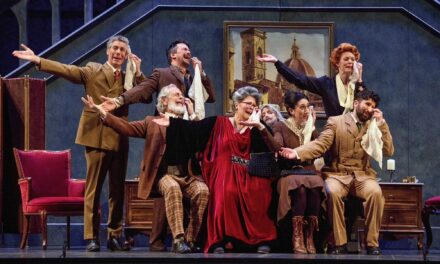Maleficent 2 isn’t groundbreaking or good, but it is enjoyable if you’re up for some cheesy, predictable fantasy

review by Gabriela Delgado
When Disney reimagined its animated classic Sleeping Beauty (1959) into the edgier 2014 Maleficent, it turned Charles Perrault’s fairytale into a dark fantasy that went on to earn a worldwide gross of $758.5 million. The success of the film immediately brought on chatter of a possible sequel that has now materialized into Maleficent 2: Mistress of Evil, a title that promised to bring Angelina Jolie’s Maleficent back into her villainous roots.
I attended my first ever IMAX screening this past Saturday October 19 to watch Maleficent 2 in a room full of people of different ages. I was seated in between an older couple and a dad and his small daughter, which gave me a good impression of the demographic that Disney was aiming for: basically the entire family. I didn’t have many expectations for the film; I only wanted to be entertained, as I usually am by any production bearing the Disney print. After experiencing 118 minutes of CGI, predictable plot and surprisingly good acting, I reached my verdict: Maleficent 2 isn’t groundbreaking or good, but it is enjoyable if you’re up for some cheesy, predictable fantasy. Some might even say that it’s enough to justify the price of admission.
The film is set a few years after Maleficent woke Aurora (Elle Fanning) from her magical slumber. Aurora, now twenty-one, rules fairly over the Moors (the fairy kingdom) alongside her beloved godmother, and everything seems to have settled since the events of the first film. A long-awaited marriage proposal from Prince Phillip sets the entire plot in motion, with both Maleficent and Queen Ingrith (Michelle Pfeiffer), Phillip’s mother, opposing the union and ultimately triggering a war between humans and fairies.

Maleficent 2 is carried entirely by the three main women on the cast, and they are the best elements the film has to offer. Angelina Jolie is good; she isn’t given much to do, thanks to a very subpar script, but she relishes in her first blockbuster comeback in years. As Maleficent, she has to confront her possessive, motherly feelings for Aurora and how they cause conflict with her hatred towards humans. Angelina Jolie does angry, vengeful Maleficent perfectly, but once again, the poor screenwriting does little to help her achieve the level of sentimental turmoil the film was trying to portray.
Elle Fanning, on the other hand, is a revelation. She’s given equal amount of screen time as Angelina Jolie, and is able to convey Aurora’s journey from a child of the forest into the unfamiliar realm of royalty that she’d been taken from. Aurora is finally a character in her own right and not just a plot device, as she was in the original Maleficent. She stands out as the more rational character out of all the others, balancing out Maleficent and Queen Ingrith’s prejudices and ultimately uniting the kingdoms.
Last but not least, Michelle Pfeiffer is fabulously evil as Queen Ingrith of Ulstead, Phillip’s controlling mother, and the main source of trouble throughout the film. Pfeiffer is a captivating image of wealth and power, at times even stealing focus from Angelina Jolie’s striking Maleficent. Although her motives are explained towards the end of the film, they still didn’t feel completely justified and rounded out. Queen Ingrith ended up as the stereotypical Evil Queen rather than a fleshed out character: she was just evil because someone had to be worse than Maleficent.
Despite Jolie, Fanning and Pfeiffer’s efforts, the film, is mediocre at best. As a sequel, it lacks the novelty and edgy stamp that made the first one so appealing to audiences worldwide. It made 48% less in its first opening weekend than the first Maleficent, with a $36.9 million gross across the USA and Canada, and a worldwide total of $155.1 million. Although it tries to subvert fairy tale tropes once more, like the original did, by having women be the instigators and men be the peacemakers, and by having Maleficent and Aurora’s familial love conquer rather than romantic love, it’s betrayed by a very messy plot. The screenwriting tries to blend three different storylines into one: Aurora and Phillip’s engagement, Queen Ingrith’s revenge, and Maleficent’s discovery of other fairies like herself. The end result is a jumbled story that was sacrificed in favour of many scenes filled with some of the worst CGI I’ve seen in years.
The IMAX experience only contributed to the artificiality of the CGI, making the numerous magical characters such as the fairies and nymphs that reside in the Moors stand out for all the wrong reasons. They don’t look organic and like they could belong to the real world; instead they bring attention to the poor quality of their 3D modelling. This was particularly surprising as Disney is considered a pioneer in special effects and animation.
The introduction of other winged and horned creatures like Maleficent feels abrupt and predictable, and does nothing to further explore the world of the film. Their only purpose is to introduce Maleficent as a Messiah to her people, effectively changing her status from antihero to hero. The character had already been drastically changed from a villain into a protagonist with the casting of Angelina Jolie, and the choice of moving the spotlight from Aurora towards Maleficent in the previous film.
Maleficent 2 isn’t great by any means. It lacks focus by trying to do too much, it is more CGI than reality, and does little to challenge what had been established by its predecessor. It only exists because of the immense success the first one experienced and because of its star-studded cast. While it presents its audience with great acting, it isn’t enough to justify the chaotic screenwriting and world building. It seems a lot more like a classic fairytale than 2014’s Maleficent, with stereotypical characters and plot points, and while it was entertaining, it wasn’t Disney magic at its best.



